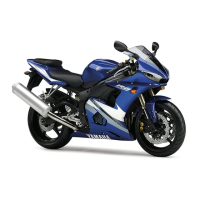REAR BRAKE
4-36
▼▼▼▼ ▼ ▼▼▼▼▼▼▼▼▼ ▼ ▼▼▼▼ ▼ ▼▼▼▼ ▼ ▼▼▼▼▼▼▼
a. Blow compressed air into the brake hose joint
opening “a” to force out the piston from the
brake caliper.
WARNING
EWA13550
• Cover the brake caliper piston with a rag.
Be careful not to get injured when the pis-
ton is expelled from the brake caliper.
• Never try to pry out the brake caliper pis-
ton.
b. Remove the brake caliper piston seals.
▲▲▲▲ ▲ ▲▲▲▲▲▲▲▲▲ ▲ ▲▲▲▲ ▲ ▲▲▲▲ ▲ ▲▲▲▲▲▲▲
EAS22640
CHECKING THE REAR BRAKE CALIPER
1. Check:
• Brake caliper piston “1”
Rust/scratches/wear → Replace the brake
caliper pistons.
• Brake caliper cylinder “2”
Scratches/wear → Replace the brake caliper
assembly.
• Brake caliper body “3”
Cracks/damage → Replace the brake caliper
assembly.
• Brake fluid delivery passages
(brake caliper body)
Obstruction → Blow out with compressed air.
WARNING
EWA13610
Whenever a brake caliper is disassembled,
replace the brake caliper piston seals.
2. Check:
• Brake caliper bracket “1”
Cracks/damage → Replace.
EAS22650
ASSEMBLING THE REAR BRAKE CALIPER
WARNING
EWA13620
• Before installation, all internal brake com-
ponents should be cleaned and lubricated
with clean or new brake fluid.
• Never use solvents on internal brake com-
ponents as they will cause the piston seals
to swell and distort.
• Whenever a brake caliper is disassembled,
replace the brake caliper piston seals.
Recommended brake component replace-
ment schedule
Brake pads If necessary
Piston seals Every two years
Brake hoses Every four years
Brake fluid
Every two years and
whenever the brake
is disassembled
a
Recommended fluid
DOT 4
1

